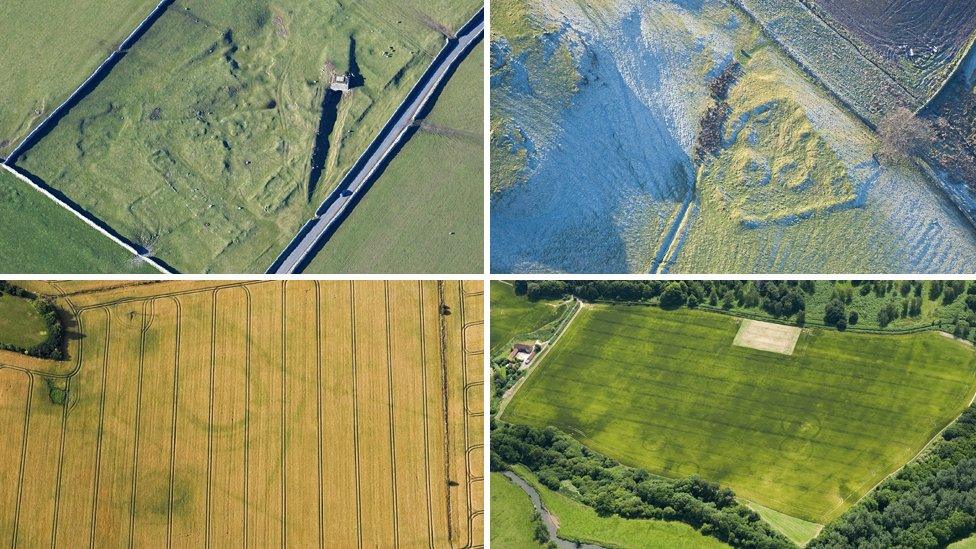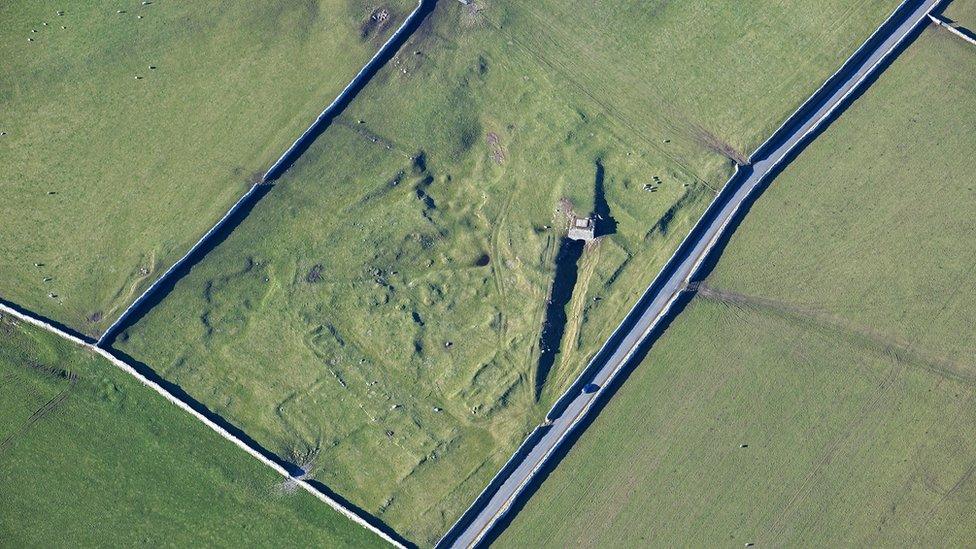Aerial photos reveal Neolithic and Bronze Age remains
- Published

Discoveries include (clockwise from top left) a monastic grange and Iron Age/Roman settlement in Cumbria, a Bronze Age barrow in West Sussex and a Neolithic "henge" in East Yorkshire
A Neolithic monument and a Bronze Age cemetery are some of the remains spotted from the skies by archaeologists.
Historic England also discovered the remnants of a Roman military camp and medieval settlements.
Aerial pictures have been made public to mark the Festival of Archaeology, external.
Discoveries were made in Cumbria, Cambridgeshire, Dorset, East Yorkshire, Buckinghamshire, Suffolk, West Sussex and West Midlands.

Bradford Abbas, Dorset - Roman Camp

Remains of a Roman Camp in Bradford Abbas, Dorset, can be seen in the crops
Roman camps were temporary enclosures dug by troops on manoeuvres. The line marking out the buried camp can be seen as different colours in the crops across several fields.
The distinctive playing card shaped enclosure is indicative of a camp and raises the question of whether it could be part of an early Roman military campaign against the local population, Historic England said.

Comberton, Cambridgeshire - Iron Age/Roman Settlement

Round houses and ditched enclosures were seen among a settlement in Comberton
A dry summer in 2015 revealed crop marks in Comberton, which helped experts see the extent of an Iron Age/Roman settlement with ditched enclosures, round houses and trackways.
Crop marks are caused by buried archaeological remains, which hold more moisture than the surrounding undisturbed soil.

Coventry - World War Two air raid shelter

Dark rectangles in the grass show the filled in remains of the trenches
Traces of a Second World War air raid shelter in Coventry's Radford Road recreation ground are visible as dark rectangles in the grass, despite being partly demolished after the war.
It is a poignant reminder of the aerial bombardment the city endured during the conflict, the heritage agency said.

Fittleworth, West Sussex - Bronze Age Barrow

Cropmarks show about five or six circular buried ditches in the field
Photographs taken last year show five or six circular ditches, which would have surrounded Bronze Age barrows.
They would have been used by the living for ceremonies and as burial sites.

Gilsmere Sike, Cumbria - Iron Age/Roman Settlement

This aerial shot captured in winter revealed a settlement and two round houses
Low winter sunlight revealed details of this Iron Age/Roman settlement in Killington, showing two round houses as well as the remains of medieval ploughing.
The settlement is depicted by the parallel ridges and furrows which shows the area was used for agricultural purposes for centuries.

Hornsea, East Yorkshire - Neolithic henge

The rare Neolithic henge is protected as a scheduled monument
A dry summer also helped the aerial reconnaissance team to identify a rare and unusual prehistoric site with a central feature thought to be a "henge" - a circular or oval-shaped bank.
The site, which dates back between four and five thousand years, is surrounded by a field system which suggests it was reused as a settlement from the Bronze Age.
It is considered so important it has since been protected as a scheduled monument., external

Lavenham, Suffolk - Medieval farm

A medieval farm in Lavenham was abandoned after changes in farming practices
Crop marks in this picture reveal a late medieval farmstead showing the farm's field boundaries and tracks linking it to neighbouring farms.
The farms were abandoned after changes in farming practice but it shows how generations of families lived on the land, experts have said.

Shap, Cumbria - Monastic grange and lime kiln

Quick lime was used to make lime putty for building
This image shows the remains of a lime kiln, which produced quick lime for building and fertiliser.
It also reveals earth-covered ruins of buildings and walls from before the kiln, thought to be a medieval monastic farm called a grange.

Stoke Hammond, Buckinghamshire - Neolithic long mortuary enclosures

The crop marks show elongated capsule shaped enclosures that are from the Neolithic period
Historic England said the elongated capsule shapes in the field were Neolithic long mortuary enclosures, thought to be where the dead were placed before burial.
They are surrounded by natural marks in the ground made in the last Ice Age.